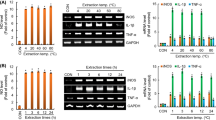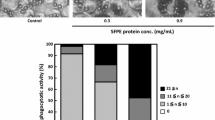Abstract
Dried bonito is a preserved food used in Japan, which contains abundant flavor ingredients and functional substances. We focused on the immunostimulatory effect of dried bonito extract (DBE) on mouse macrophage-like J774.1 cells, RAW264.7 cells, and mouse primary peritoneal macrophages. DBE significantly stimulated the production of tumor necrosis factor-α (TNF-α) and interleukin-6 (IL-6) by both J774.1 cells and peritoneal macrophages by enhancing the cytokine gene expression levels. In addition, DBE stimulated nitric oxide production by enhancing the expression of inducible nitric oxide synthase in RAW264.7 cells. DBE also increased the phagocytosis activity of J774.1 cells. Immunoblot analysis revealed that DBE has an immunostimulatory effect on macrophages through activation of mitogen-activated protein kinase and nuclear factor-κB cascades. TNF-α production enhanced by DBE was partially inhibited by treatment with TLR4 inhibitor TAK-242, whereas IL-6 production enhanced by DBE was almost inhibited. These results suggested that DBE is thought to strongly stimulate the TLR4 signaling pathway for macrophage activation, and its activation is also involved in other signaling. Finally, the phagocytosis activity of peritoneal macrophages from DBE-administered BALB/c mice increased significantly, suggesting that DBE has the potential to stimulate macrophage activity in vivo. In conclusion, these data indicated that DBE contributes to activating host defense against pathogens by activating innate immunity.








Similar content being viewed by others
References
Aderem A, Ulevitch RJ (2000) Toll-like receptors in the induction of the innate immune response. Nature 406:782–787
Aoki K, Matsubara S, Umeda M, Tachibana S, Doi M, Takenaka S (2013) Aspartic protease from Aspergillus (Eurotium) repens strain MK82 is involved in the hydrolysis and decolourisation of dried bonito (Katsuobushi). J Sci Food Agric 93:1349–1355
Blander JM, Medzhitov R (2004) Regulation of phagosome maturation by signals from Toll-like receptors. Science 304:1014–1018
Bonizzi G, Karin M (2004) The two NF-κB activation pathways and their role in innate and adaptive immunity. Trends Immunol 25:280–288
Chen BC, Chen YH, Lin WW (1999) Involvement of p38 mitogen-activated protein kinase in lipopolysaccharide-induced iNOS and COX-2 expression in J774 macrophages. Immunology 97:124–129
Curtis JM, Dennis D, Waddell DS, MacGillivray T, Ewart HS (2002) Determination of angiotensin-converting enzyme inhibitory peptide Leu-Lys-Pro-Asn-Met (LKPNM) in bonito muscle hydrolysates by LC-MS/MS. J Agric Food Chem 50:3919–3925
Ding AH, Nathan CF, Stuehr DJ (1988) Release of reactive nitrogen intermediates and reactive oxygen intermediates from mouse peritoneal macrophages. Comparison of activating cytokines and evidence for independent production. J Immunol 141:2407–2412
Ghosh S, Karin M (2002) Missing pieces in the NF-κB puzzle. Cell 109:S81–S96
Hambleton J, Weinstein SL, Lem L, DeFranco AL (1996) Activation of c-Jun N-terminal kinase in bacterial lipopolysaccharide-stimulated macrophages. Proc Natl Acad Sci USA 93:2774–2778
Ii M, Matsunaga N, Hazeki K, Nakamura K, Takashima K, Seya T, Hazeki O, Kitazaki T, Iizawa Y (2006) A novel cyclohexene derivative, ethyl (6R)-6-[N-(2-chloro-4-fluorophenyl)sulfamoyl]cyclohex-1-ene-1-carboxylate (TAK-242), selectively inhibits Toll-like receptor 4-mediated cytokine production through suppression of intracellular signaling. Mol Pharmacol 69:1288–1295
Ishida M, Nishi K, Watanabe H, Sugahara T (2013) Inhibitory effect of aqueous spinach extract on degranulation of RBL-2H3 cells. Food Chem 136:322–327
Ishida M, Ose S, Nishi K, Sugahara T (2016) Immunostimulatory effect of spinach aqueous extract on mouse macrophage-like J774.1 cells and mouse primary peritoneal macrophages. Biosci Biotechnol Biochem 80:1393–1402
Karin M (1995) The regulation of AP-1 activity by mitogen-activated protein kinases. J Biol Chem 270:16483–16486
Karin M, Liu Z, Zandi E (1997) AP-1 function and regulation. Curr Opin Cell Biol 9:240–246
Kouno K, Hirano S, Kuboki H, Kasai M, Hatae K (2005) Effects of dried bonito (Katsuobushi) and captopril, an angiotensin I-converting enzyme inhibitor, on rat isolated aorta: a possible mechanism of antihypertensive action. Biosci Biotechnol Biochem 69:911–915
Kumalasari ID, Nishi K, Harmayani E, Raharjo S, Sugahara T (2013) Effect of bengkoang (Pachyrhizus erosus) fiber extract on murine macrophage-like J774.1 cells and mouse peritoneal macrophages. J Funct Foods 5:582–589
Lin W, Hwang D (2008) Application of species-specific PCR for the identification of dried bonito product (Katsuobushi). Food Chem 106:390–396
Ma J, Chen T, Mandelin J, Ceponis A, Miller NE, Hukkanen M, Ma GF, Konttinen YT (2003) Regulation of macrophage activation. Cell Mol Life Sci 60:2334–2346
Matsumoto J, Ishikawa S, Doi M, Kishida T, Ebihara K (2007) Protease-resistant fraction of smoked, dried bonito alleviates atopic dermatitis-like skin lesions in NC/Nga mice. J Nutr Sci Vitaminol 53:451–456
Matsunaga N, Tsuchimori N, Matsumoto T, Ii M (2011) TAK-242 (resatorvid), a small-molecule inhibitor of Toll-like receptor (TLR) 4 signaling, binds selectively to TLR4 and interferes with interactions between TLR4 and its adaptor molecules. Mol Pharmacol 79:34–41
Matthews JR, Hay RT (1995) Regulation of the DNA binding activity of NF-κB. Int J Biochem Cell Biol 27:865–879
Medzhitov R (2008) Origin and physiological roles of inflammation. Nature 454:428–435
Miyake Y, Ito C, Itoigawa M, Osawa T (2009) Antioxidants produced by Eurotium herbariorum of filamentous fungi used for the manufacture of karebushi, dried bonito (Katsuobushi). Biosci Biotechnol Biochem 73:1323–1327
Moncada S, Palmer RMJ, Higgs EA (1991) Nitric oxide: physiology, pathophysiology, and pharmacology. Pharmacol Rev 43:109–142
Nathan C (1992) Nitric oxide as a secretory product of mammalian cells. FASEB J 6:3051–3064
Pu Z, Carrero JA, Unanue ER (2002) Distinct recognition by two subsets of T cells of an MHC class II-peptide complex. Proc Natl Acad Sci USA 99:8844–8849
Putra ABN, Morishige H, Nishimoto S, Nishi K, Shiraishi R, Doi M, Sugahara T (2012) Effect of collagens from jellyfish and bovine Achilles tendon on the activity of J774.1 and mouse peritoneal macrophage cells. J Funct Foods 4:504–512
Sanghera JS, Weinstein SL, Aluwalia M, Girn J, Pelech SL (1996) Activation of multiple proline-directed kinases by bacterial lipopolysaccharide in murine macrophages. J Immunol 156:4457–4465
Schindler H, Lutz MB, Röllinghoff M, Bogdan C (2001) The production of IFN-γ by IL-12/IL-18-activated macrophages requires STAT4 signaling and is inhibited by IL-4. J Immunol 166:3075–3082
Su B, Karin M (1996) Mitogen-activated protein kinase cascades and regulation of gene expression. Curr Opin Immunol 8:402–411
Suzuki E, Umezawa K (2006) Inhibition of macrophage activation and phagocytosis by a novel NF-κB inhibitor, dehydroxymethylepoxyquinomicin. Biomed Pharmacother 60:578–586
Takeuchi O, Akira S (2010) Pattern recognition receptors and inflammation. Cell 140:805–820
Vodovotz Y, Bogdan C, Paik J, Xie Q, Nathan C (1993) Mechanisms of suppression of macrophage nitric oxide release by transforming growth factor β. J Exp Med 178:605–613
Xie Q, Kashiwabara Y, Nathan C (1994) Role of transcription factor NF-κB/Rel in induction of nitric oxide synthase. J Biol Chem 269:4705–4708
Yokoyama K, Chiba H, Yoshikawa M (1992) Peptide inhibitors for angiotensin I-converting enzyme from thermolysin digest of dried bonito. Biosci Biotechnol Biochem 56:1541–1545
Zhang Y, Dong C (2005) MAP kinases in immune responses. Cell Mol Immunol 2:20–27
Acknowledgements
We thank members of the Advanced Research Support Center (ADRES), Ehime University for the use of animal facility.
Author contributions
MI, KN, KS, NK, and TS conceived and designed the experiments. MI and KS, and NK performed the experiments and analyzed the data. MI, KN, and TS wrote the manuscript.
Author information
Authors and Affiliations
Corresponding author
Ethics declarations
Conflict of interest
Katsuhiro Osajima, Tomokazu Suemitsu, and Takuya Sugahara are inventors in a patent application filed by Ehime University, which disclose bioactive agents targeting immunostimulation described in the present article. The remaining authors declare no conflict of interest.
Additional information
Practical Application: Although dried bonito contains abundant flavor ingredients and functional substances, it was unclear whether dried bonito affects macrophage activation leading to enhancement of the immune system. In this study, the extract from dried bonito showed immunostimulatory effects on experimental animals as well as on cell lines. Our findings suggest that DBE would be a novel functional food for immunostimulation with academic significance and that daily intake of DBE contributes to the maintenance of human health with enhancement of the immunity due to macrophage activation.
Electronic supplementary material
Below is the link to the electronic supplementary material.
Rights and permissions
About this article
Cite this article
Ishida, M., Nishi, K., Shinohara, K. et al. Immunostimulatory effect of dried bonito extract on mouse macrophage cell lines and mouse primary peritoneal macrophages. Cytotechnology 69, 229–244 (2017). https://doi.org/10.1007/s10616-016-0053-4
Received:
Accepted:
Published:
Issue Date:
DOI: https://doi.org/10.1007/s10616-016-0053-4




